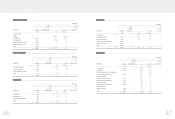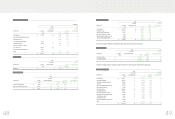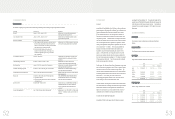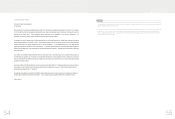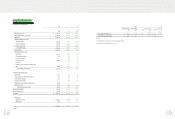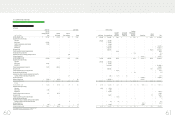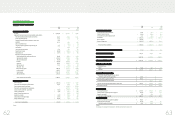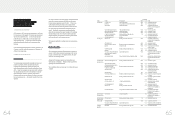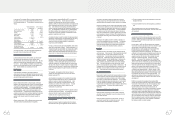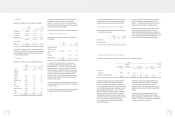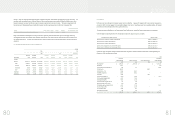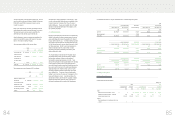HTC 2009 Annual Report Download - page 87
Download and view the complete annual report
Please find page 87 of the 2009 HTC annual report below. You can navigate through the pages in the report by either clicking on the pages listed below, or by using the keyword search tool below to find specific information within the annual report.
ownership of the goods, primarily upon shipment, because the
earnings process has been completed and the economic benefits
associated with the transaction have been realized or are realizable.
Revenue is measured at the fair value of the consideration received
or receivable and represents amounts agreed between the Company
and the customers for goods sold in the normal course of business,
net of sales discounts and volume rebates. For trade receivables
due within one year from the balance sheet date, as the nominal
value of the consideration to be received approximates its fair value
and transactions are frequent, fair value of the consideration is not
determined by discounting all future receipts using an imputed rate
of interest.
An allowance for doubtful accounts is provided on the basis of a
review of the collectability of accounts receivable. The Company
assesses the probability of collections of accounts receivable by
examining the aging analysis of the outstanding receivables and
assessing the value of the collateral provided by customers.
Inventories
Inventories consist of raw materials, supplies, finished goods and
work-in-process. Before January 1, 2008, inventories were stated
at the lower of cost or market value (replacement cost or net
realizable value). Any write-down was made on a category by
category basis. Market value meant replacement cost for raw
materials and supplies and net realizable value for finished goods
and work in process. As stated in Note 4, effective January 1,
2008, inventories are stated at the lower of cost or net realizable
value. Inventory write-downs are made item by item, except
where it may be appropriate to group similar or related items. Net
realizable value is the estimated selling price of inventories less all
estimated costs of completion and costs necessary to make the
sale. Cost is determined using the moving-average method.
Financial Assets Carried at Cost
Investments in equity instruments with no quoted prices in an active
market and with fair values that cannot be reliably measured, such
as non-publicly traded stocks and stocks traded in the emerging
stock market, are measured at their original cost. The accounting
treatment for dividends on financial assets carried at cost is similar
to that for dividends on available-for-sale financial assets. An
impairment loss is recognized when there is objective evidence that
the asset is impaired. A reversal of this impairment loss is
disallowed.
Bond Investments Not Quoted in An Active Market
Bond investments not quoted in an active market are stated at
amortized cost and are classified as current or noncurrent on the
basis of their maturities.
Bond investments not quoted in an active market - current are
investments receiving fixed or determinable amounts. Other
features of these bond investments are as follows:
a. The bond investments have not been designated as at fair value
through profit or loss.
b. The bond investments have not been designated as available for
sale.
Those investments that are noncurrent are classified as bond
investment not quoted in an active market - noncurrent under funds
and investments.
Investments Accounted for by the Equity Method
Investments in which the Company holds 20 percent or more of the
investees’ voting shares or exercises significant influence over the
investees’ operating and financial policy decisions are accounted for
by the equity method.
Prior to January 1, 2006, the difference between the acquisition
cost and the Company’s proportionate share in the investee’s equity
was amortized by the straight-line method over five years.
Effective January 1, 2006, pursuant to the revised Statement of
Financial Accounting Standard (SFAS) No. 5, “Long-term
Investments Accounted for by Equity Method”, the acquisition cost
is allocated to the assets acquired and liabilities assumed based on
their fair values at the date of acquisition, and the excess of the
acquisition cost over the fair value of the identifiable net assets
acquired is recognized as goodwill. Goodwill is not being
amortized. The excess of the fair value of the net identifiable
assets acquired over the acquisition cost is used to reduce the fair
value of each of the noncurrent assets acquired (except for financial
assets other than investments accounted for by the equity method,
noncurrent assets held for sale, deferred income tax assets, prepaid
pension or other postretirement benefit) in proportion to the
respective fair values of the noncurrent assets, with any excess
recognized as an extraordinary gain. Effective January 1, 2006,
the accounting treatment for the unamortized investment premium
arising on acquisitions before January 1, 2006 is the same as that
for goodwill and the premium is no longer being amortized. For
any investment discount arising on acquisitions before January 1,
2006, the unamortized amount continues to be amortized over the
remaining year.
Profits from downstream transactions with an equity-method
investee are eliminated in proportion to the Company’s percentage
of ownership in the investee; however, if the Company has control
over the investee, all the profits are eliminated. Profits from
upstream transactions with an equity-method investee are
eliminated in proportion to the Company’s percentage of ownership
in the investee. When the Company subscribes for its investee’s
newly issued shares at a percentage different from its percentage
of ownership in the investee, the Company records the change in its
equity in the investee’s net assets as an adjustment to investments,
with a corresponding amount credited or charged to capital surplus.
When the adjustment should be debited to capital surplus, but the
capital surplus arising from long-term investments is insufficient,
the shortage is debited to retained earnings.
)LQDQFLDO,QIRUPDWLRQ
In January 2007 and October 2008, the Company wholly acquired
the shares issued by Communication Global Certification Inc. and
One & Company Design, Inc. The fair values of net assets were as
follows:
Communication Global
Certification Inc.
One & Company
Design, Inc.
Cash on hand and in banks $ 39,961 $ 7,336
Other current assets 40,201 12,378
Property 175,940 16,620
Intangible assets 174,253 115,055
Other assets 3,913 164
Current liabilities ( 63,315 ) ( 15,220 )
Long-term bank loans ( 90,050 ) -
Other liabilities ( 903 ) -
Total consideration $ 280,000 $ 136,333
Total consideration 280,000 $ 136,333
Cash on hand and in banks ( 39,961 ) ( 7,336 )
Net cash outflow on the
acquisition of a subsidiary $ 240,039 $ 128,997
As mentioned in Note 1, HTC and the foregoing subsidiaries are
hereinafter referred to collectively as the “Company.”
Current/Noncurrent Assets and Liabilities
Current assets include cash, cash equivalents, and those assets
held primarily for trading purposes or to be realized, sold or
consumed within one year from the balance sheet date. All other
assets such as properties and intangible assets are classified as
noncurrent. Current liabilities are obligations incurred for trading
purposes or to be settled within one year from the balance sheet
date. All other liabilities are classified as noncurrent.
Cash Equivalents
Cash equivalents, consisting of repurchase agreements
collateralized by bonds, are highly liquid financial instruments with
maturities of three months or less when acquired and with carrying
amounts that approximates their fair values.
Financial Assets/Liabilities at Fair Value through Profit or Loss
Financial instruments classified as financial assets or financial
liabilities at fair value through profit or loss (FVTPL) include financial
assets or financial liabilities held for trading and those designated
as at FVTPL on initial recognition. The Company recognizes a
financial asset or a financial liability on its balance sheet when the
Company becomes a party to the contractual provisions of the
financial instrument. A financial asset is derecognized when the
Company has lost control of its contractual rights over the financial
asset. A financial liability is derecognized when the obligation
specified in the relevant contract is discharged, cancelled or
expired.
Financial instruments at FVTPL are initially measured at fair value.
Transaction costs directly attributable to the acquisition
of financial assets or financial liabilities at FVTPL are recognized
immediately in profit or loss. At each balance sheet date
subsequent to initial recognition, financial assets or financial
liabilities at FVTPL are remeasured at fair value, with changes in fair
value recognized directly in profit or loss in the year in which they
arise. Cash dividends received subsequently (including those
received in the year of investment) are recognized as income for the
year. On derecognition of a financial asset or a financial liability,
the difference between its carrying amount and the sum of the
consideration received and receivable or consideration paid and
payable is recognized in profit or loss.
A derivative that does not meet the criteria for hedge accounting is
classified as a financial asset or a financial liability held for trading.
If the fair value of the derivative is positive, the derivative is
recognized as a financial asset; otherwise, the derivative is
recognized as a financial liability.
Fair values of financial assets and financial liabilities at the balance
sheet date are determined as follows: Publicly traded stocks - at
closing prices; open-end mutual funds - at net asset values; bonds
- at prices quoted by the Taiwan GreTai Securities Market; and
financial assets and financial liabilities without quoted prices in an
active market - at values determined using valuation techniques.
Available-for-sale Financial Assets
Available-for-sale financial assets are initially measured at fair
value plus transaction costs that are directly attributable to the
acquisition. At each balance sheet date subsequent to initial
recognition, available-for-sale financial assets are remeasured at
fair value, with changes in fair value recognized in equity until the
financial assets are disposed of, at which time, the cumulative gain
or loss previously recognized in equity is included in profit or loss
for the year.
The recognition, derecognition and the fair value bases of
available-for-sale financial assets are the same with those of
financial assets at FVTPL.
Cash dividends are recognized on the stockholders’ resolutions,
except for dividends distributed from the pre-acquisition profit,
which are treated as a reduction of investment cost. Stock
dividends are not recognized as investment income but are
recorded as an increase in the number of shares. The total
number of shares subsequent to the increase is used for
recalculation of cost per share.
An impairment loss is recognized when there is objective evidence
that the financial asset is impaired. Any subsequent decrease in
impairment loss for an equity instrument classified as
available-for-sale is recognized directly in equity.
Revenue Recognition, Accounts Receivable and Allowance for
Doubtful Accounts
Revenue from sales of goods is recognized when the Company
has transferred to the buyer the significant risks and rewards of
)LQDQFLDO,QIRUPDWLRQ


